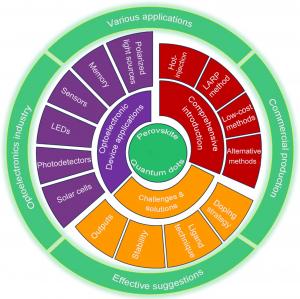From solar cells to quantum tech: the rise of perovskite quantum dots
GA, UNITED STATES, October 12, 2025 /EINPresswire.com/ -- Perovskite quantum dots (PQDs) are rapidly emerging as a transformative material for solar cells, light-emitting diodes (LEDs), photodetectors, and even quantum communication systems. With remarkable light absorption, high color purity, and tunable electronic properties, PQDs promise to boost efficiency and enable advanced applications that conventional semiconductors cannot match. However, their performance is hindered by stability issues, including degradation under light, moisture, and oxygen. Recent research highlights innovative fabrication strategies, degradation insights, and performance enhancement approaches—such as ligand engineering, ion doping, and encapsulation—to improve device stability and efficiency. These advances chart a promising pathway toward next-generation optoelectronics and quantum technologies.
Metal halide perovskites have revolutionized photovoltaics and optoelectronics due to their low cost, tunable bandgaps, and strong light absorption. Among them, Perovskite quantum dots (PQDs)—nanocrystals only a few nanometers in size—stand out for their extraordinary photoluminescence and quantum confinement effects, offering nearly 100% efficiency in light conversion. Their versatility enables integration into solar cells, Light-Emitting Diodes (LEDs), sensors, and memory devices. Yet, PQDs face intrinsic challenges such as instability under illumination and rapid degradation in humid environments. These limitations pose significant barriers to their commercialization. Based on these challenges, there is a pressing need to conduct deeper research into PQDs’ fabrication, degradation, and performance optimization.
A comprehensive review led by researchers from Sejong University and collaborating institutions, published on June 24, 2025 in Carbon Energy, provides an in-depth analysis of perovskite quantum dots. The paper outlines recent breakthroughs in PQD synthesis, stability challenges, and performance enhancement strategies. The study highlights how PQDs can revolutionize solar cells, photodetectors, LEDs, and quantum devices, while emphasizing the urgent need to address degradation and environmental sensitivity.
The review details how PQDs can be synthesized using methods such as hot-injection and ligand-assisted reprecipitation, enabling size- and composition-tunable bandgaps across the visible spectrum. These techniques yield nanocrystals with photoluminescence efficiencies approaching 100%. However, PQDs' instability under light, oxygen, and moisture remains a central obstacle. Photodegradation leads to lattice distortions and iodine vacancies, while exposure to water rapidly triggers phase transitions and structural collapse. To overcome these issues, researchers have developed several strategies. Ligand modification—replacing long-chain organic ligands with shorter, more stable molecules—improves charge transport and photostability. Ion doping with elements such as sodium, rubidium, and copper enhances thermal resistance, air stability, and optical properties. Encapsulation using polymers, oxides, or metal-organic frameworks further shields PQDs from environmental stress, significantly extending their operational lifespan. Collectively, these innovations push solar cell efficiencies above 17% and enable applications in high-brightness LEDs, sensitive photodetectors, resistive memory devices, and quantum communication technologies. The review concludes that targeted surface engineering and protective strategies will be critical for realizing PQDs' commercial potential.
"Perovskite quantum dots offer an unprecedented combination of tunability, efficiency, and versatility," said Najaf Rubab, corresponding author of the study. "But their instability has been a roadblock to practical deployment. Our review shows that with advances in surface chemistry, doping, and encapsulation, these challenges can be systematically addressed. PQDs are no longer just laboratory curiosities—they are poised to become building blocks for solar energy, advanced lighting, memory technologies, and quantum communication if stability hurdles can be overcome."
The advancement of PQDs opens a pathway to practical solutions in renewable energy, consumer electronics, and information technology. In solar power, PQDs' tunable bandgaps and light-harvesting properties could drive more affordable and efficient photovoltaic modules. In optoelectronics, they promise brighter, more energy-efficient LEDs and ultrasensitive detectors for imaging and sensing. Their resistive switching capabilities may reshape data storage, while quantum optics applications—such as nanolasers and polarized light detectors—hold potential for secure communications. By combining fabrication innovation with protective strategies, PQDs could bridge the gap between laboratory research and large-scale commercial deployment.
References
DOI
10.1002/cey2.70018
Original Source URL
https://doi.org/10.1002/cey2.70018
Funding information
This study was supported by the National Research Foundation of Korea (NRF) grant funded by the Korean government (MSIT) (no. RS-2022-00165798). The authors extend their appreciation to the Deanship of Scientific Research at King Khalid University for funding this study through a large group Research Project under grant number (RGP-2/454/45).
Lucy Wang
BioDesign Research
email us here
Legal Disclaimer:
EIN Presswire provides this news content "as is" without warranty of any kind. We do not accept any responsibility or liability for the accuracy, content, images, videos, licenses, completeness, legality, or reliability of the information contained in this article. If you have any complaints or copyright issues related to this article, kindly contact the author above.

